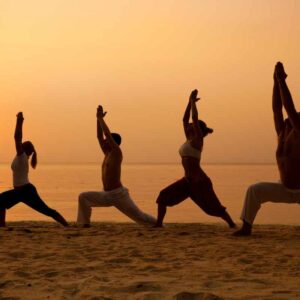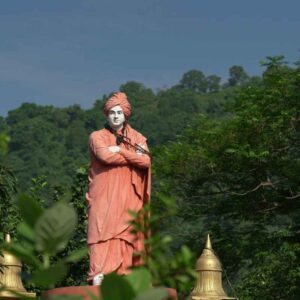Yoga: Its Origin, History And Development

In today’s fast-paced life, many individuals discover yoga as a pathway to attain balance, peace, and a profound connection between mind, body, and spirit. Yoga, with roots tracing back to ancient times, is far from a modern trend. Throughout this blog, we’ll embark on a journey through the ages, delving into the origin, history, and development of yoga, including its relevance in sought-after Yoga Teacher Training in Bali.

Origin Of Yoga
-
Ancient Roots
Yoga’s story begins from the ancient Indian philosophy, where the Vedas and Upanishads laid the groundwork for this transformative practice. In the Vedic period, yoga was the means for individuals to connect with the divine and understand their place in the cosmic order. The word “yoga” itself is derived from Sanskrit, meaning union, reflecting the holistic approach of merging the physical, mental, and spiritual aspects of an individual.
Yoga philosophy introduces the concept of a universal consciousness and the idea that individuals can attain a higher state of being through self-discipline, ethical living, and the practice of yoga.
-
Early Practices
The earliest systematic formulation of yoga can be found in the Yoga Sutras of Patanjali, dating back to around 400 CE. Patanjali’s teachings introduced the concept of the eight limbs of yoga, encompassing ethical guidelines, physical postures, breath control, and meditation.
Eights Limbs Of Yoga Are:-
-
Yama (moral codes)
It is said to be the first limb of ashtanga yoga. It refers to our daily routine behaviour which tells us how to live a better life.
It includes Ahimsa (Non- violence), Satya (Truth), Asteya (Non- Stealing), Brahmacharya (Self- Control) and Aparigraha (Non- greedy).
-
Niyama (self-discipline)
It is the guidelines for better and healthy living. It includes 5 disciplines namely: Saucha (cleanliness), Santosha (Modesty), Tapas (Keeping body healthy), Svadhyaya (Self-inquiry) and Ishvara pranidhana (Surrender to God).
-
Asana (posture)
It means to sit in a comfortable and stable position. It provides us stability and health.
-
Pranayama (breath control)
The word Pranayama is composed of two words ‘prana’ meaning life and energy and ‘ayama’ meaning to control. It involves controlling your breath in different styles and for different duration.
-
Pratyahara (sense withdrawal)
The word Pratyahara is composed of two words ‘Prati’ meaning against and ‘ahara’ meaning food or anything which is taken into ourselves. So it means not to be taken or accepted by our body. It includes withdrawal of senses and to control our mind and desires.
-
Dharana (concentration)
Dharana is the initial stage of deep meditation. It is the ability to focus or concentrate on a particular thing.
- Dhyana (meditation) – Dhyana is to maintain deep concentration and focus without any interruption. By skilling Dhyana it will lead you to Samadhi.
- Samadhi (oneness with the self) – Samadhi is the mind’s ultimate state. In samadhi your mind becomes still and your consciousness unites with the universal consciousness.
Historical Development
-
Evolution of Yoga
As time flew, yoga underwent significant transformations during the classical period. This era, which spanned roughly from 500 BCE to 800 CE, saw the consolidation and expansion of yogic philosophy and practices.
-
Philosophical Foundations By Patanjali
Patanjali’s contributions to yoga are enclosed in the “Yoga Sutras,” a seminal work that provides a systematic and comprehensive framework for the practice of yoga. Comprising 195 sutras, Patanjali’s text offers guidance not only on the physical aspects of yoga but also on the mental and spiritual dimensions.
-
Path To Spiritual Realization
Patanjali’s teachings provided a structured path for seekers to navigate the complexities of the human experience and attain spiritual realization. The Eight Limbs offer a holistic approach, addressing not only the physical body through asana but also the mental and spiritual dimensions through meditation, ethical conduct, and self-discipline.
-
Tantra And Hatha Yoga

The emergence of Tantra (Includes rituals, meditation, and visualization to awaken spiritual energy) and Hatha Yoga (Focuses on physical postures and breath control) marked a shift toward the physical dimension of the practice. Emphasizing postures (asanas), breath control (pranayama), and energy centers (chakras), these branches made yoga more accessible to a broader audience.
Spread Of Yoga: Yoga In The West
The journey of yoga took an extraordinary turn during the 19th and 20th centuries when it went beyond its usual places and became popular in the West. The coming together of ancient Eastern wisdom and modern Western ways of thinking had a big impact on how yoga is seen all around the world. This mix of old and new ideas played a key role in how yoga is practiced globally.
Key Influencers:-
- Swami Vivekananda :

One of the earliest ambassadors of yoga to the West was Swami Vivekananda. In 1893, he addressed the Parliament of the World’s Religions in Chicago, introducing the concept of yoga. He described yoga as a “science of the mind”, and translated Yogic texts from Sanskrit to English.
- Paramahansa Yogananda :

Yogananda, another influential figure, brought the teachings of Kriya Yoga (an ancient meditation technique of energy and breath control, or pranayama) to the West. His book, “Autobiography of a Yogi,” became a spiritual classic and inspired many to explore the depths of yoga and meditation.
Conclusion
As we head towards the future, yoga shows no signs of slowing down. Its adaptability and magnitude have positioned it as a transformative force in modern society. The integration of yoga into mainstream healthcare, ongoing research, and evolving trends suggest a promising and dynamic future for this ancient practice.
Nowadays people are making their future as Yoga teachers. They are taking Yoga Teacher Training sessions from all around the world. Those who are beginners they are looking for 100 Hour Yoga Teacher Training and advancing themselves in Yoga by skilling in 200 Hour Yoga Teacher Training and 300 Hour Yoga Teacher Training.
Hence we can say that Yoga was part of us in ancient times and it has gained its importance so much that it will not be coming down, it will be learned and practiced all around the world with great enthusiasm.



